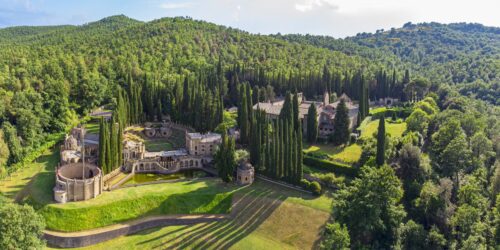
By Francesco Bianchini
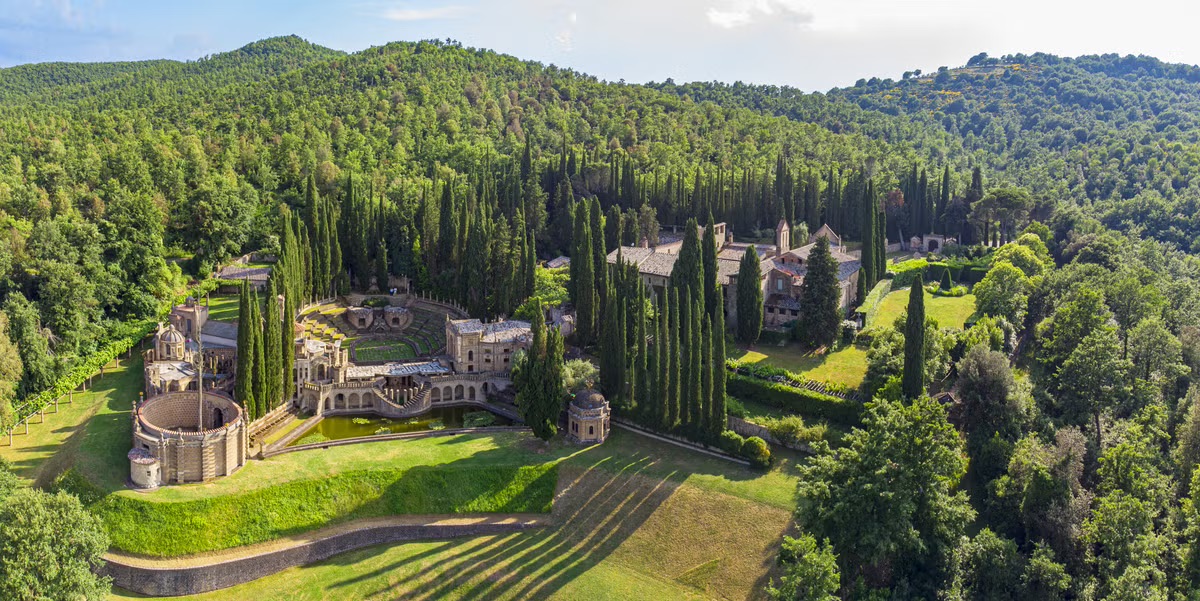
In Xanadu did Kubla Khan a stately pleasure dome decree.
On the border with Tuscany, near Orvieto, the land is rugged; outcroppings of rock, barren escarpments of clay, earth carved by rushing streams. Here Umbria resembles the wash drawings of Giovanni di Paolo, the frescoes of Sodoma and Piero della Francesca. An exodus by farmers from country to cities caused farmland to be abandoned, but the countryside preserves its ancient beauty—fields of wild vegetation, wooded valleys where blackberries and broom take root. Here and there, flocks of sheep graze on verdant hills; towns perch atop the remnants of dormant volcanoes brooding on their heights, just as Lorenzetti painted them, and as Gabriele d’Annunzio described them.
A few miles from Montegiove lies a secluded dale submerged in oaks and chestnuts, undulating with olive trees like gray watered silk. Here a copse of pointy cypresses breaks the sky—a common sight on Tuscan hills but one that in Umbria usually signals a graveyard or a monastery. Driving in the glen, beyond a curve on the white gravel road, a bell tower comes into view, then a low roof, a chapel. I hold my breath as a bulwark of stone, a last fringe of trees, a boundary wall, an iron gate, a garden, reveal themselves little-by-little. Whenever I return to La Scarzuola, I wonder if I can describe its elusive, uncommonly evocative power—for the path to it, laid down by its designers, is not at all simple nor straightforward; and the intentions of those who came to live here overlap, one on top of the other, like geological strata in cross-sections of rock.
Saint Francis was the first genius loci of La Scarzuola, excluding traces of pre-Celtic cults. During his sojourn, Francis is said to have planted clumps of rose and laurel bushes whence sprang water, bubbling forth, and giving birth to a marsh reed called scarza. Thus the name. Disciples drew near, following the saint in his wanderings throughout Umbria. He and these friars took up residence, working side-by-side with peasants in return for modest meals. The band preached and sang songs in what may have been the happiest days of Francis’ younger life—free to traipse through meadows, woods, valleys; to hear in the melody of streams and winds, and in the song of birds, what he perceived to be the Divine language.
Francis called his followers the Order of Minori—the little ones—and his ‘minori’ later took to building churches and convents where he had lingered. Thus, beside the saint’s spring at La Scarzuola, a small church was built, fronted with a columned portico in the Umbrian fashion, with a graveyard at one side and the lodgings of the brothers on the other. The friars planted orchards and vineyards, rows of healing plants, and laid down paths among the plunging hills and dales, where only the call of the cuckoo and the sound of their own footsteps dispelled the silence. Over the centuries, they extended La Scarzuola’s walled perimeter, cultivating more of its surrounding land, planting larger orchards and vineyards, endowing their little chapel with frescoes inspired by the Fioretti of their founder and patron.
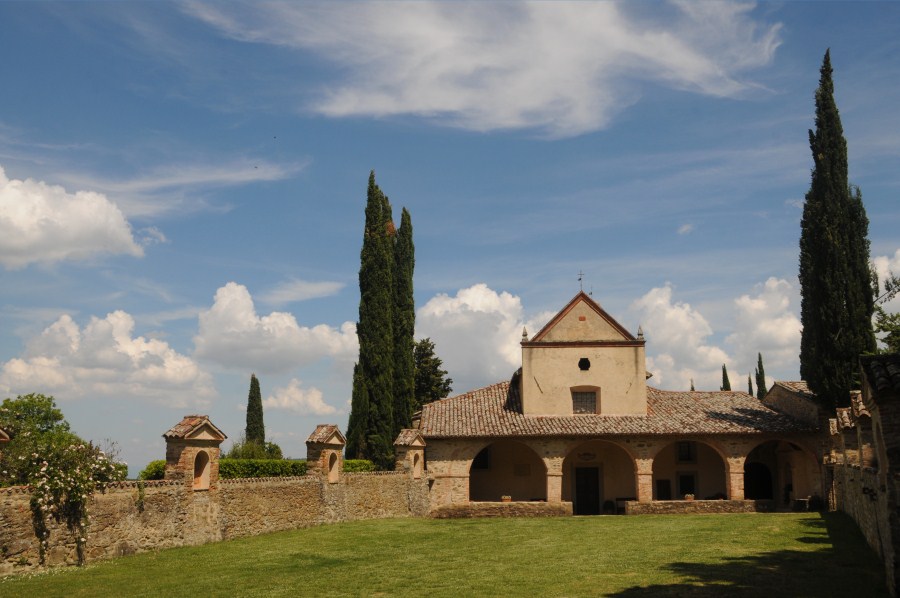
Saint Francis’ church
Seven centuries later a solitary and aging man acquired La Scarzuola after the last of its hermits had died. Tomaso Buzzi—a diminutive, sardonic, and restless architect of the Mussolini era; a restorer of Palladian villas, decorator of embassies, suitor of high society (and its sneering critic)—had the idea of making La Scarzuola into the ‘miniature Pompeii of a lonely man, and of one man alone.’ As a first step, Buzzi appropriated the church to shelter the archives of his career—books and objets d’art—and took up residence in the brothers’ old quarters, renouncing electricity, telephones, and central heating. His plan for reorganizing the property soon came into focus: ‘part castle, convent, villa, city.’ The work proceeded during the last twenty years of his life, each varying concept progressing without definite drawings. Buzzi himself personally supervised his laborers, enduring feverish workdays at the end of which he retired to dream of yet more additions, more alterations.
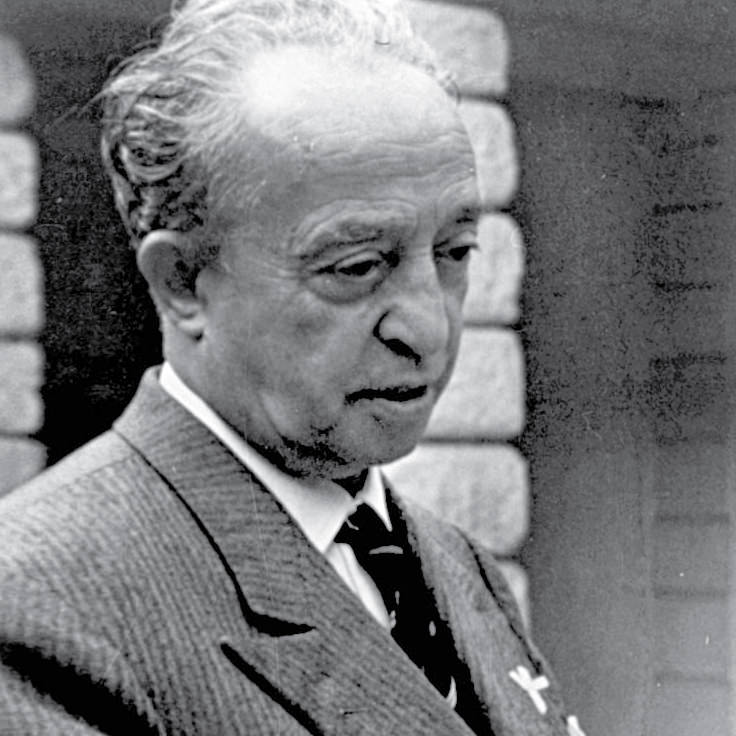
Tomaso Buzzi (1900-1981)
He erected palaces, colonnades, staircases and spires with poor perishable materials—porous tufa and rustable iron—producing an effect of the unfinished, the decayed, and the fossilized: all because, ‘palaces change hands, are modified, and destroyed; only the ruins remain.’ The resulting città Buzziana, built a stone’s throw from the ancient church and convent of the Franciscans, is a separate world altogether, appearing like a sprawling Temptation of Saint Anthony on the point of crumbling down—an ephemeral and cryptic mirage overlooking a landscape of briers and forests.
The città ideale and the Franciscan convent coexist as two faces of Buzzi’s odd personality: the convent is the refuge of a man of the world, one living a dreamlike and secret life among his papers, drawings, paintings, and sculptures, with a few friars’ cells for guests, but without comforts to encourage prolonged stays. (Indeed, in Buzzi’s day, there wasn’t even a kitchen—save that of the groundskeeper where his wife cooked for the architect too.) Larger rooms were crammed with his treasures—architectural fragments, pilasters, gilded cornices, heraldic devices, tapestries, and baroque church fittings—all stacked atop one another and waiting to find a place in his grand stage setting—or, perhaps, just destined to rot, get dusty and worm-eaten.
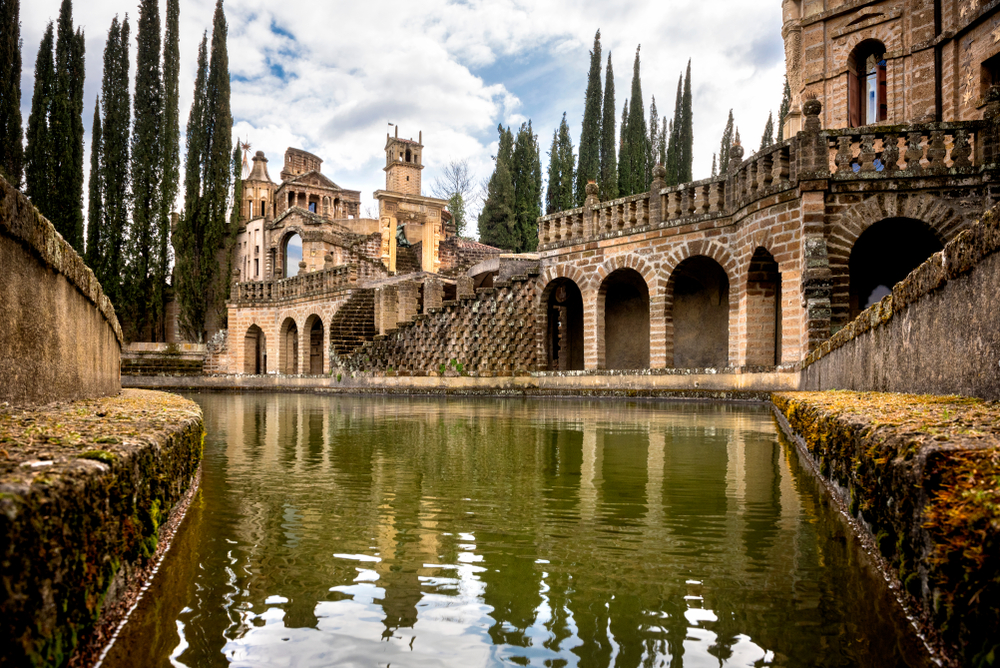
Buzzi’s creation searching for itself
Keeping everything in this unkempt way—unfinished, neglected, abandoned—never bothered Buzzi; on the contrary, he was pleased to arrange a savant désordre. Valuables were treated with apparent detachment, nonchalantly thrown together with junk; precious books strewn about; paintings casually leaned against walls; sculptures and marble fragments provisionally teetering on this and that; fine fabrics and antique embroideries cast to the four winds. He created a daydream, growing ever vaster, more complex, richer in secret meanings—in allusions, echoes, fantasies, incrustations, and memories. When reproved for altering the Franciscan inspiration of the site, Buzzi replied that his città ‘in its way, in stone, is the Cantico delle Creature—with sister water, earth and flowers, sun and moon, animals and people; with art and poetry, music and birds, with clouds, sky, and stars.’
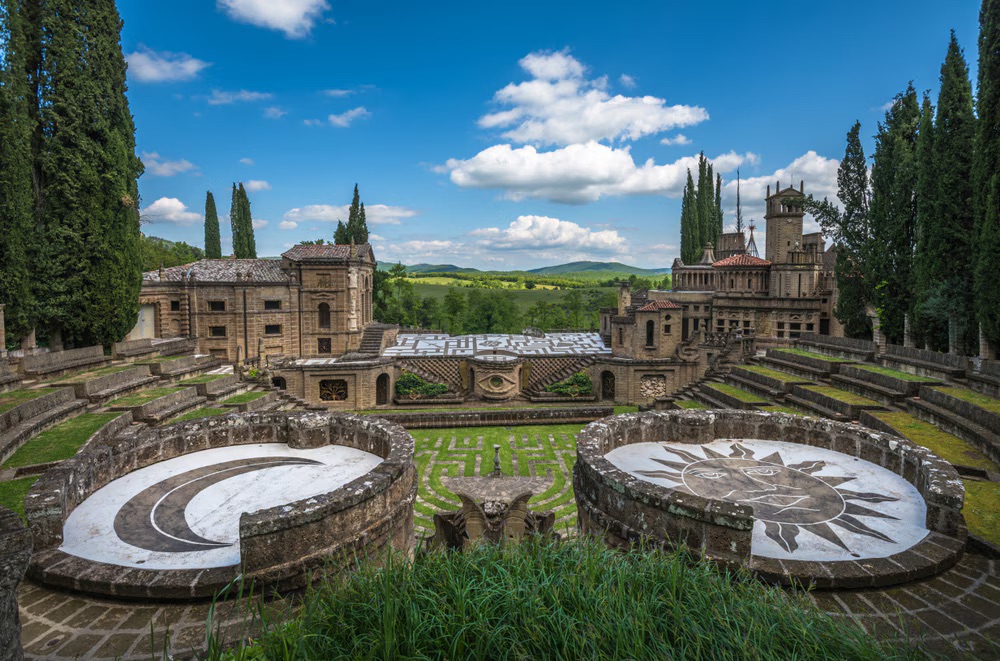
Father Sun and Sister Moon
In the years after Buzzi died, ivy took no time to cover the walls, to dig its roots into the stones like hibernating snakes. Pale moss and lichen patterned the walls, underbrush obscured the outlines of holm oaks and laurel hedgerows, and more than a few stones rolled to the foot of the buildings, like fragments around the Sphinx. Lizards, snakes, sparrows, badgers, and pigeons took up residence like flocks of sheep roaming the deserted palaces of Petra. Abandoned and overgrown, an intricate baroque landscape as in a Piranesi engraving, was how La Scarzuola appeared to Marco Solari who inherited the estate after the death of Buzzi, his great uncle. Now his full-time dedication is to the arduous task of continuing the work—in surprising sympathy with his uncle, with the cunning of a Penelope, undoing her shroud when no one is looking. The weeds have been eradicated, stones gathered, hedges trimmed, grassy slopes around buildings and escarpments mowed regularly—Marco himself drives the big lawn-mowing tractor—and the work proceeds, with materials being shifted to and fro, concrete prepared, masons sculpting blocks of tufa, while other workers labor atop stumps of unfinished towers on which one can only see raw, bare brickwork. Yet Buzzi’s unwanted ‘finished’ look is cleverly held at bay, never achieved.
Everything remains in much the same condition visit after visit, blockaded by scaffolding, littered with construction materials, covered in layers of concrete dust. I head uphill toward the convent with a hint of disappointment and perplexity. Whatever La Scarzuola may actually be, under its thick coating of symbols, whatever it may contain or conceal, I always leave with the feeling of never having discovered it. It is enough, perhaps, merely to preserve images of Buzzi’s fantastic creations, ablaze with bronze ornaments sprouting from rooftops, with their cupolas gleaming in the afternoon light.
In a kitchenette at the end of a low building used as a dining room—which given its tiny dimensions, defies any guest to keep the cook company—Marco prepared lunch for me and Dan on a cold day, some years ago. To reach the place, we traversed a colonnaded loggia that shelters a fountain of deep water—a basin really—where rose-headed lettuces, leafy cabbages, ivory turnips, and pink-whiskered radishes bobbed in a rippling tide. I remarked that I’d never seen a more touching still life, but Marco just shrugged his shoulders. ‘My uncle always washed vegetables that way, and I still do,’ he explained. He is lanky, seventy-something, and has a way of speaking with dry, sharp inflections in which one detects a hint of distracted indifference—until his unexpected laugh explodes. But usually his remarks drop like ethnographic notes about remote and curious people.
The view from the lunch table was through long bay windows into a garden, enclosed by high hedges, with black cypresses sprouting above. Marco sat at one end of the table opposite his partner Brian, the other resident of La Scarzuola, and its self-appointed custodian of church and convent. It was not easy to follow their conversation as we were freezing from the cold—there was one small gas stove to warm the long room—and Marco, who was recounting an intricate story in Italian, was continually being interrupted by the garrulous Brian in Australian-accented English. The two seemed to disagree on every facet of the episode, even the names of the people. Dan and I, the two of us seated amidships, swivelled our heads from one end of the table to the other, like spectators at a tennis match.
It is well that we eventually left that room and migrated to a place with a more temperate climate. We were led to an orangery used in Buzzi’s day to dry laundry, which now functions as an extra moenia living room. Within a gigantic seventeenth century stone fireplace, two Lilliputian logs were burning to heat a curious system of water pipes linked to radiators that circled the room. To get warm we had to crowd together with dogs and cats as near to the hearth as possible. Brian entered with cups of hot coffee. If Marco has that certain Mediterranean sprezzatura—intellectual curiosity coupled with self-praising cynicism—Brian, on the other hand—small statured, elfin, pale, like an albino fox—is jittery, full of nervous movements, emitting a firecracker chain of jokes, stories, and quips.
After coffee, we followed Brian to his custodial domain—the ancient Franciscan church. Soft organ music emanated from a sound system hidden somewhere in the darkened apse, and once inside Brian explained bitterly how the chapel had suffered at the hands of Tomaso Buzzi, apparently strewn with rubbish and in scandalous repair for many years. Thanks to Brian’s efforts, however, the altar has been relocated to its original position, side chapels reopened, and restoration begun on paintings and frescoes—in the apse above a wooden choir stall, for example, a fourteenth century fresco dedicated to saint Francis has returned to life. Traversing the nave, we passed into the sacristy—and if that word suggests an austere room lined with dusty wardrobes, smelling of camphor and starch, nothing could be further from the truth—for La Scarzuola’s sacristy is an elegant sitting room in which one might find a bishop enthroned, seated on a high gilded chair. Arranged on a handsome antique console were the numerous invitations Brian receives: cardinal so-and-so requests the pleasure of his company for lunch, abbot X for a commemoration, the rector of Wherever-shire for the opening of the new baptistery.
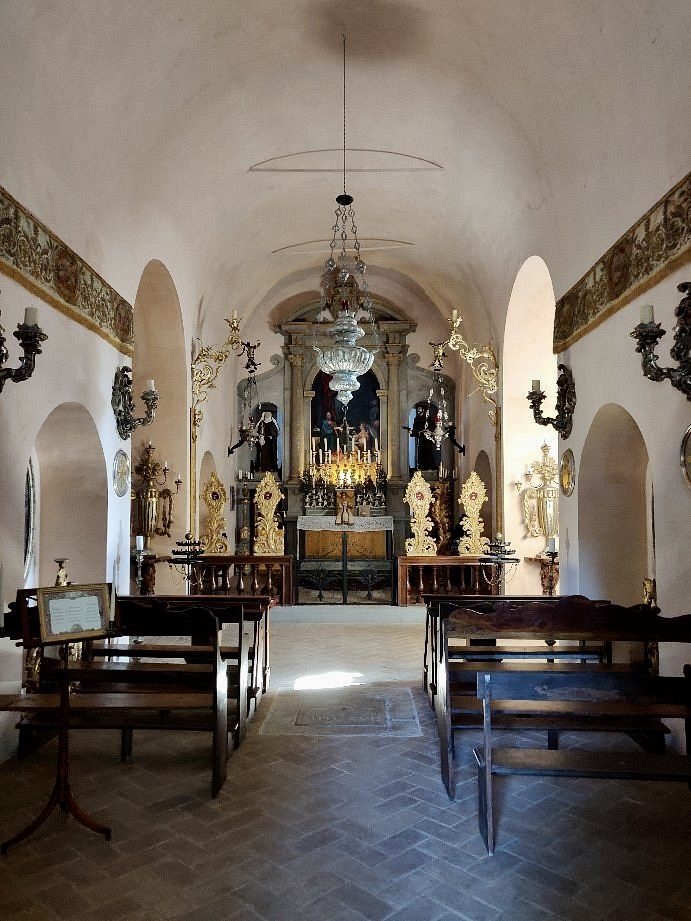
Splendor regained
Brian approached a massive chest-of-drawers facing an identical one across the somber lagoon of a silk Persian rug. From a drawer he delicately plucked what seemed to be miniature pieces of women’s lingerie. He unfolded one and smoothed it down on his lap. I was drawing a blank. He had made it himself, with his own hands, he told me, and it was for the chapel’s statue of the Virgin Mary—for her Good Friday appearance. There was her bodice with straps, a slip, and a girdle—complete with frogs for stockings. I was amazed by the fine workmanship of each piece. Realizing that no one would ever see them except Brian, I chuckled at the blasphemous idea of him dressing and undressing the Virgin Mary.
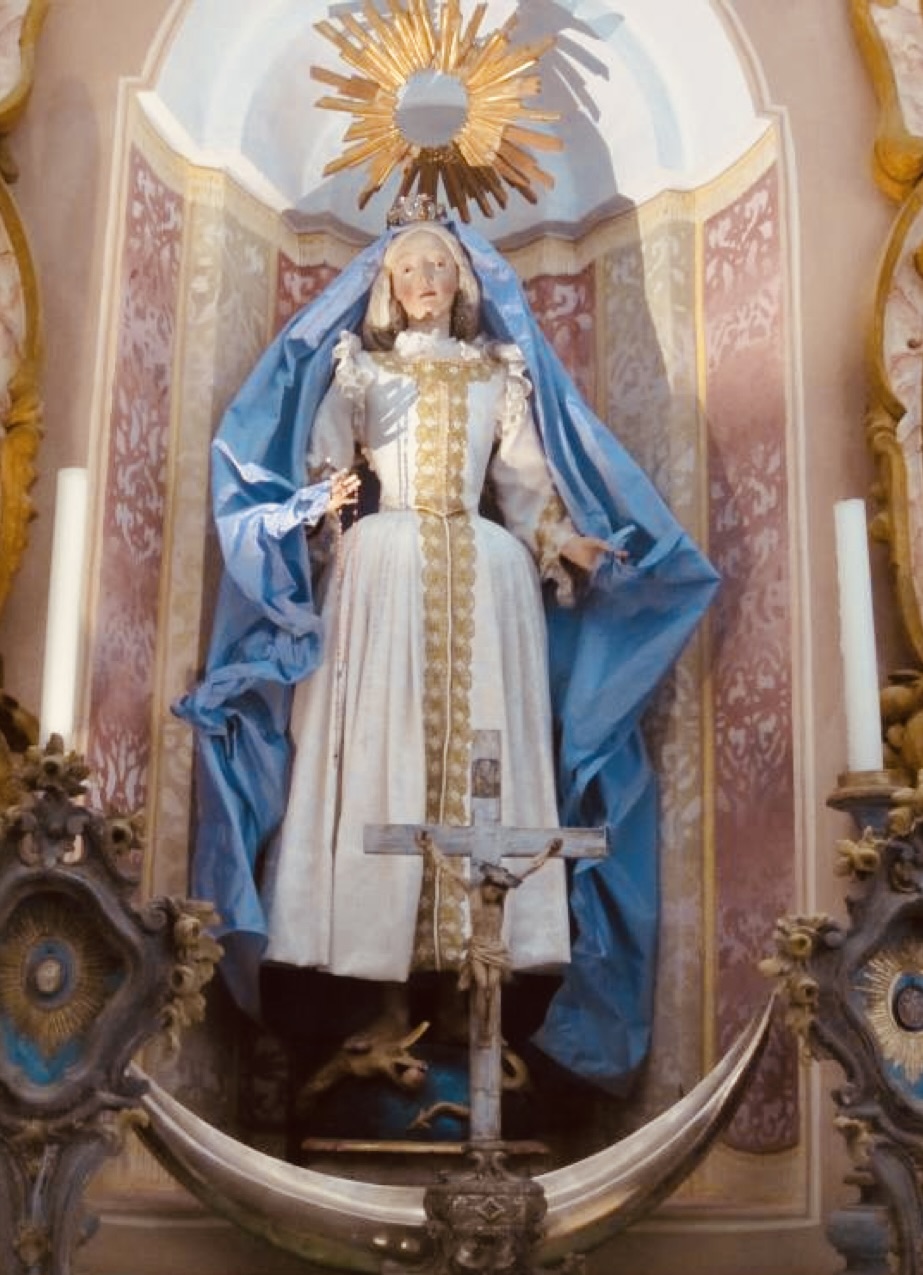
Haute couture by Brian
We passed from the sacristy into an adjoining windowless room, lit by a beautiful Murano chandelier. Hanging inside another huge wardrobe were a double tier of vestments that would make the Vatican envious: voluptuous embroidered silk and velvet capes, cassocks, chasubles, and stoles, all strewn with semi-precious stones, bedecked with fanciful lace—some possibly wrought by nuns entombed in damp beguinages. Brian unhooked two or three and, with a flourish, spread them on the rug as if they were bullfighter’s muletas—talking reverently of each piece, lingering on the quality of the fabrics, the patterns, liturgical purpose, provenance, and era in which each one was made. He described his restoration work and recited the fortuitous circumstances of finding each one in flea markets and out-of-the-way shops; the bargaining it took to buy them, the pitiful state in which they were found.
In another wardrobe, Brian disclosed orderly piles of church towels and linens, all perfectly starched and freshly scented. I asked if he was thinking of creating a museum, and he looked as though I was uttering profanities. ‘Never!’ he growled, ‘these things only have meaning if they are used regularly.’ He paused for a moment, a white tunic draped over his chest, to gaze at his image in a large gilded mirror leaning against the wall. He sighed, and with evident frustration explained the trouble he’d had with the former parish priest of Montegiove. ‘The man was reluctant to wear the vestments I selected for our every-other-Sunday service here at La Scarzuola. I was forced to resort to my Vatican connections to rectify the dispute. But nowadays,’ he said with a wink, ‘the new priest is more than happy to wear my vestments—I’ve even caught him admiring himself in the mirror!’
I promised myself I would not miss seeing one of Brian’s spectacles, so on an icy Sunday in February I went solo to join a small group of local churchgoers in his chapel. The church smelled of floor wax and incense, the walnut pews shone in the glow of candles, and from electric lights hidden in recesses of the ceiling vaults. With everything glimmering dimly, the church seemed intimate, secret, ancient. Brian—perhaps surprised that anyone had turned up at all—faced the congregation with the forced cheerfulness of a host caught off-guard by the early arrival of guests. He wore an embroidered white surplice with billowing sleeves over the top of a black cassock that swept the floor. His nose was red, congested from a cold, and his eyes flickered back and forth, checking for details that might need his attention. I was awed and at the same time amused to see how the scene—those discreet flower arrangements on low sculpted consoles, crisp and impeccably starched altar linens on which gleaming church silver stood, ornate lighted sconces adorning the walls—bespoke the forethought and care of a decorator with exquisite taste. The effect was breathtaking.
Waiting for Mass to start, the congregation floated in an ageless and gilded glow in which no element overpowered another. A bell rang, and from behind the main altar came the priest in his gorgeous vestment—French, a green-and-gold brocade chasuble dating from the nineteenth century. Brian swung a silver censer and blue, aromatic, caramel-scented smoke swirled up the columns of the altar canopy to the baroque ornamentation above. It was only then that I noticed something funny: atop a partition, hovering above a carved coat-of-arms was a small squatting cat—a stone cat with pointy ears— looking down into the nave. What was that cat doing there?—the ultimate burlesque of Tomaso Buzzi, or the homage of the animal kingdom to saint Francis?



